Communication Skills for Business
VerifiedAdded on 2023/01/11
|15
|1016
|71
Presentation
AI Summary
This presentation discusses communication models, systems, and methods in business communication. It explores the benefits of formal and informal communication, principles of effective communication, and barriers to effective communication.
Contribute Materials
Your contribution can guide someone’s learning journey. Share your
documents today.

Communication Skills for
Business
Business
Secure Best Marks with AI Grader
Need help grading? Try our AI Grader for instant feedback on your assignments.
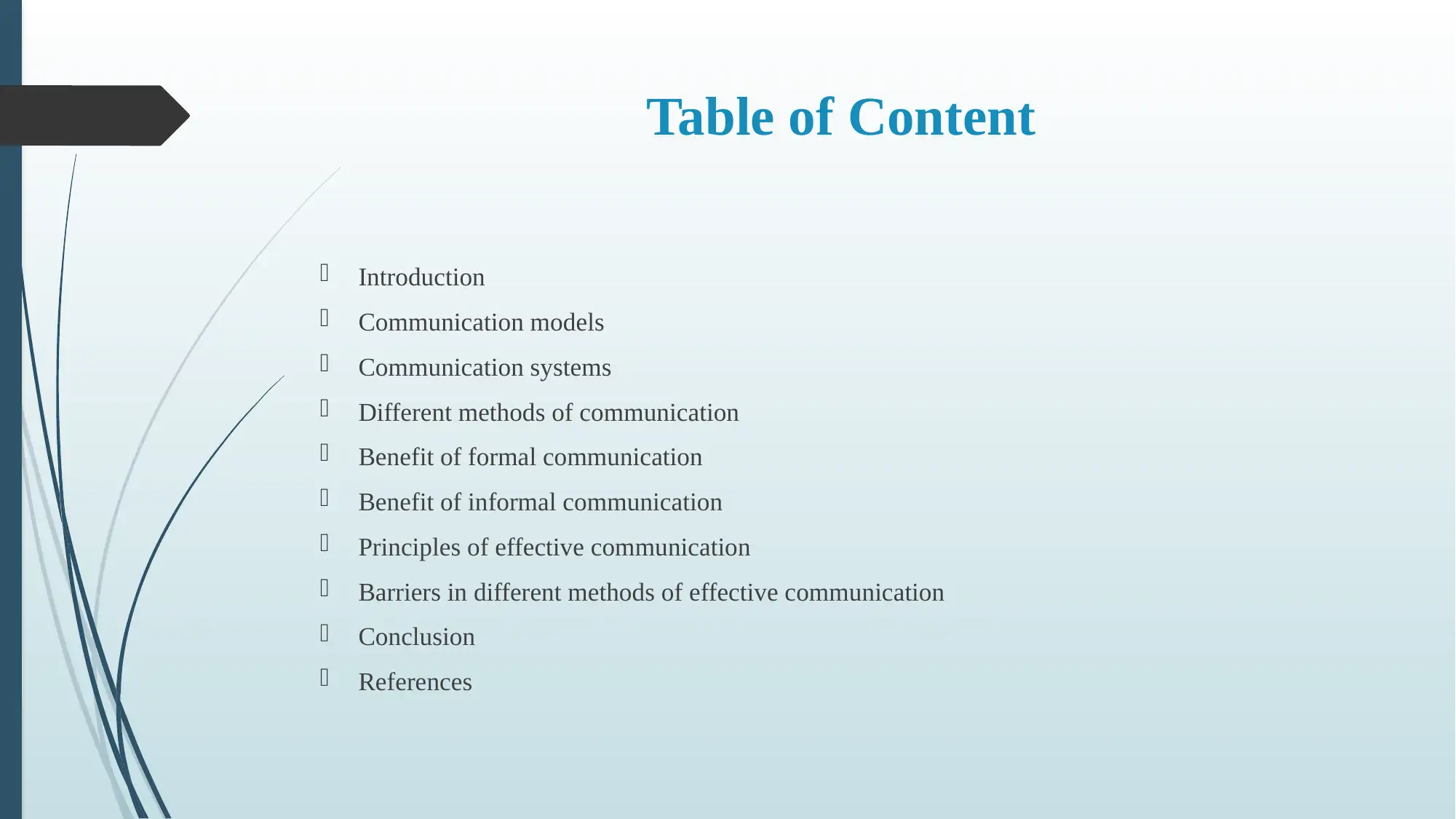
Table of Content
Introduction
Communication models
Communication systems
Different methods of communication
Benefit of formal communication
Benefit of informal communication
Principles of effective communication
Barriers in different methods of effective communication
Conclusion
References
Introduction
Communication models
Communication systems
Different methods of communication
Benefit of formal communication
Benefit of informal communication
Principles of effective communication
Barriers in different methods of effective communication
Conclusion
References
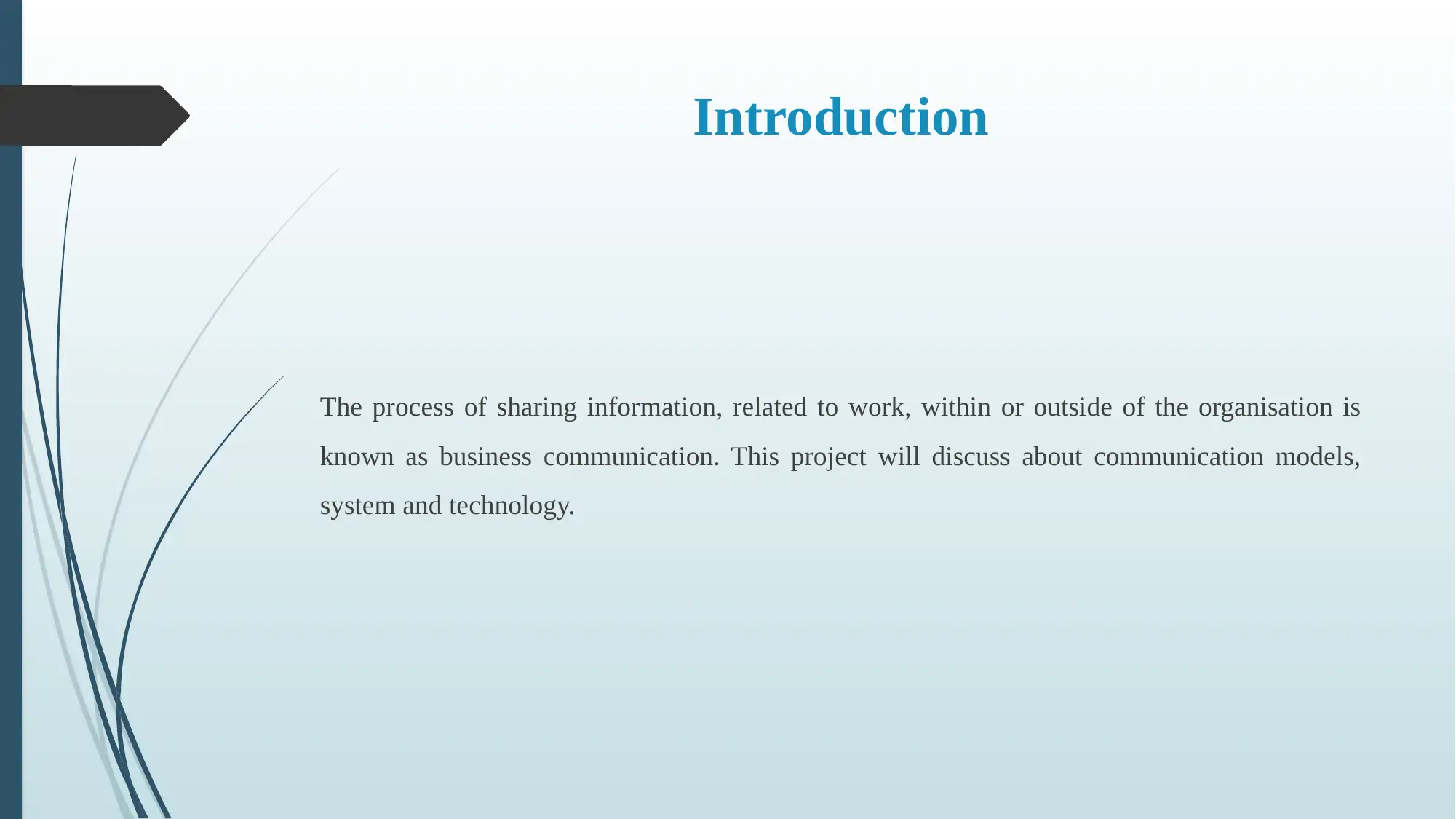
Introduction
The process of sharing information, related to work, within or outside of the organisation is
known as business communication. This project will discuss about communication models,
system and technology.
The process of sharing information, related to work, within or outside of the organisation is
known as business communication. This project will discuss about communication models,
system and technology.
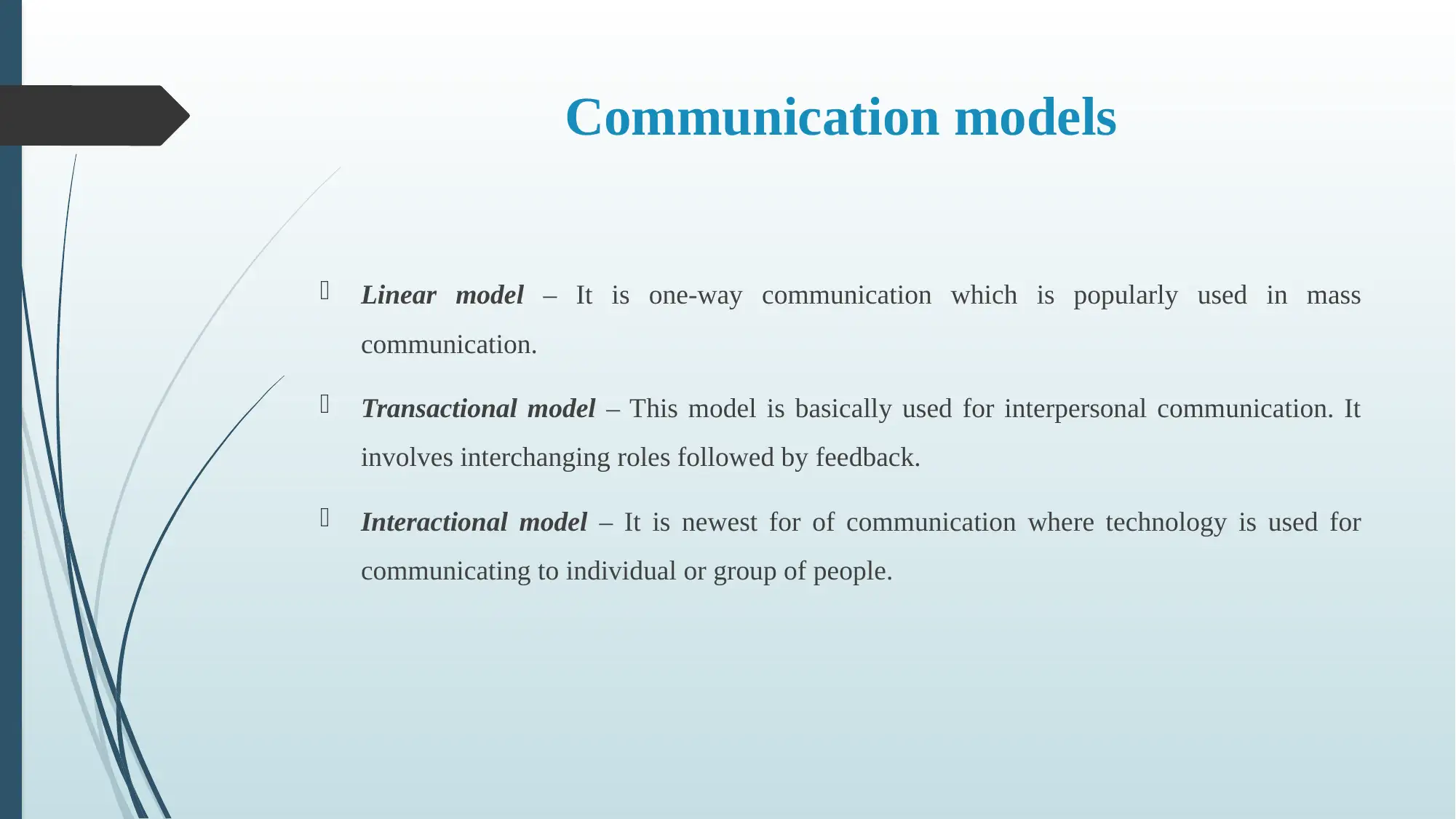
Communication models
Linear model – It is one-way communication which is popularly used in mass
communication.
Transactional model – This model is basically used for interpersonal communication. It
involves interchanging roles followed by feedback.
Interactional model – It is newest for of communication where technology is used for
communicating to individual or group of people.
Linear model – It is one-way communication which is popularly used in mass
communication.
Transactional model – This model is basically used for interpersonal communication. It
involves interchanging roles followed by feedback.
Interactional model – It is newest for of communication where technology is used for
communicating to individual or group of people.
Secure Best Marks with AI Grader
Need help grading? Try our AI Grader for instant feedback on your assignments.
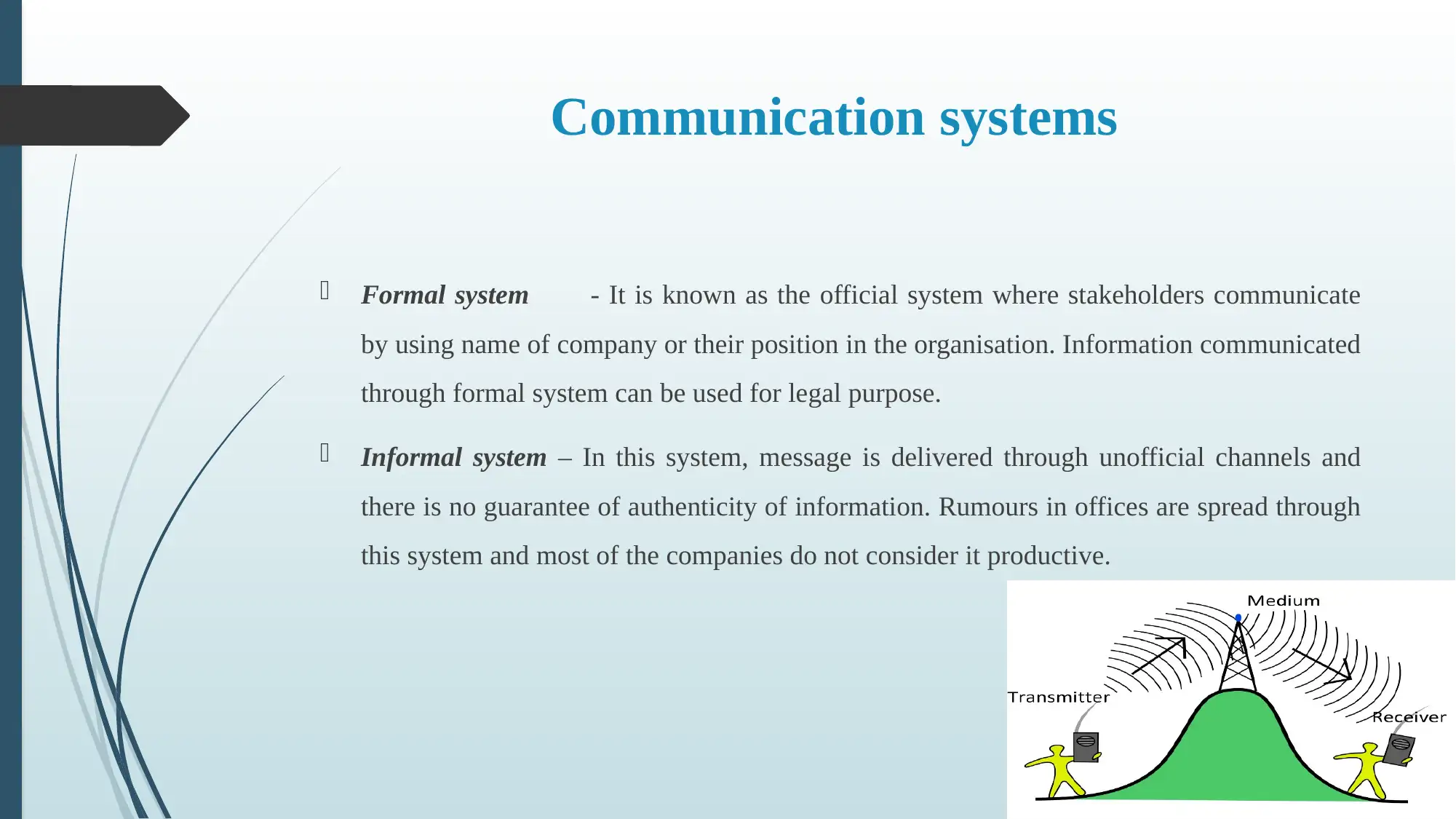
Communication systems
Formal system - It is known as the official system where stakeholders communicate
by using name of company or their position in the organisation. Information communicated
through formal system can be used for legal purpose.
Informal system – In this system, message is delivered through unofficial channels and
there is no guarantee of authenticity of information. Rumours in offices are spread through
this system and most of the companies do not consider it productive.
Formal system - It is known as the official system where stakeholders communicate
by using name of company or their position in the organisation. Information communicated
through formal system can be used for legal purpose.
Informal system – In this system, message is delivered through unofficial channels and
there is no guarantee of authenticity of information. Rumours in offices are spread through
this system and most of the companies do not consider it productive.
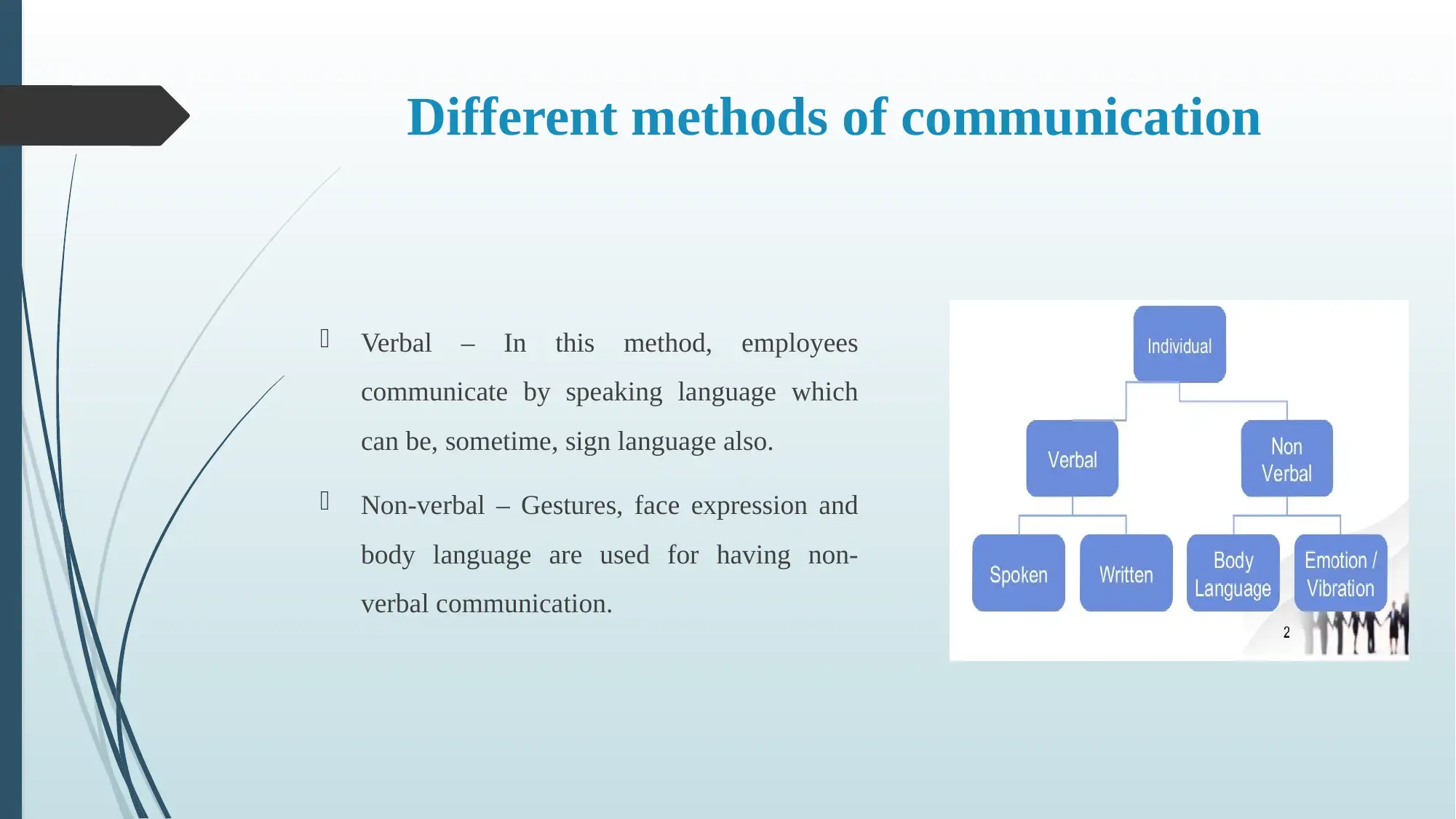
Different methods of communication
Verbal – In this method, employees
communicate by speaking language which
can be, sometime, sign language also.
Non-verbal – Gestures, face expression and
body language are used for having non-
verbal communication.
Verbal – In this method, employees
communicate by speaking language which
can be, sometime, sign language also.
Non-verbal – Gestures, face expression and
body language are used for having non-
verbal communication.
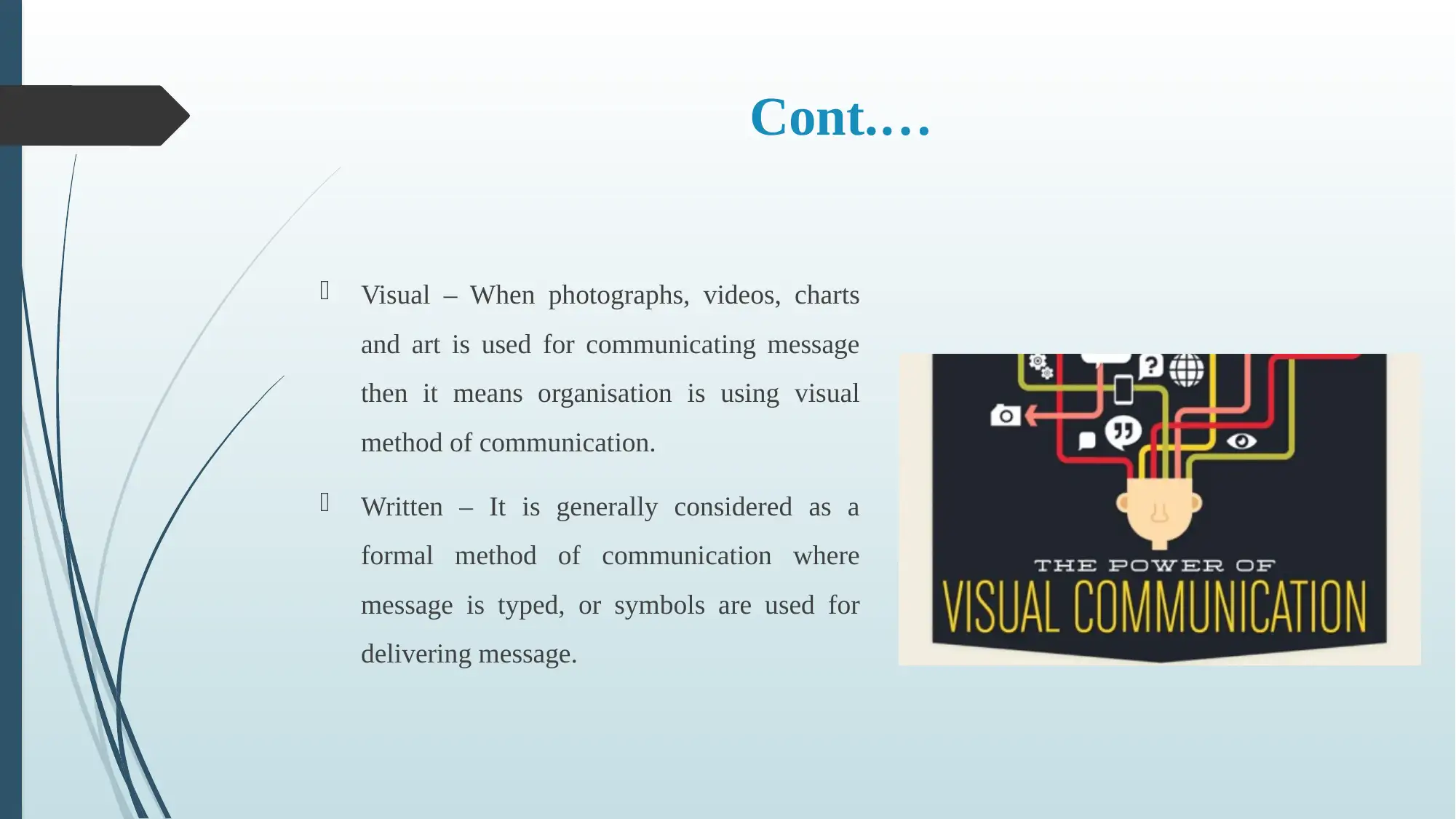
Cont.…
Visual – When photographs, videos, charts
and art is used for communicating message
then it means organisation is using visual
method of communication.
Written – It is generally considered as a
formal method of communication where
message is typed, or symbols are used for
delivering message.
Visual – When photographs, videos, charts
and art is used for communicating message
then it means organisation is using visual
method of communication.
Written – It is generally considered as a
formal method of communication where
message is typed, or symbols are used for
delivering message.
Paraphrase This Document
Need a fresh take? Get an instant paraphrase of this document with our AI Paraphraser
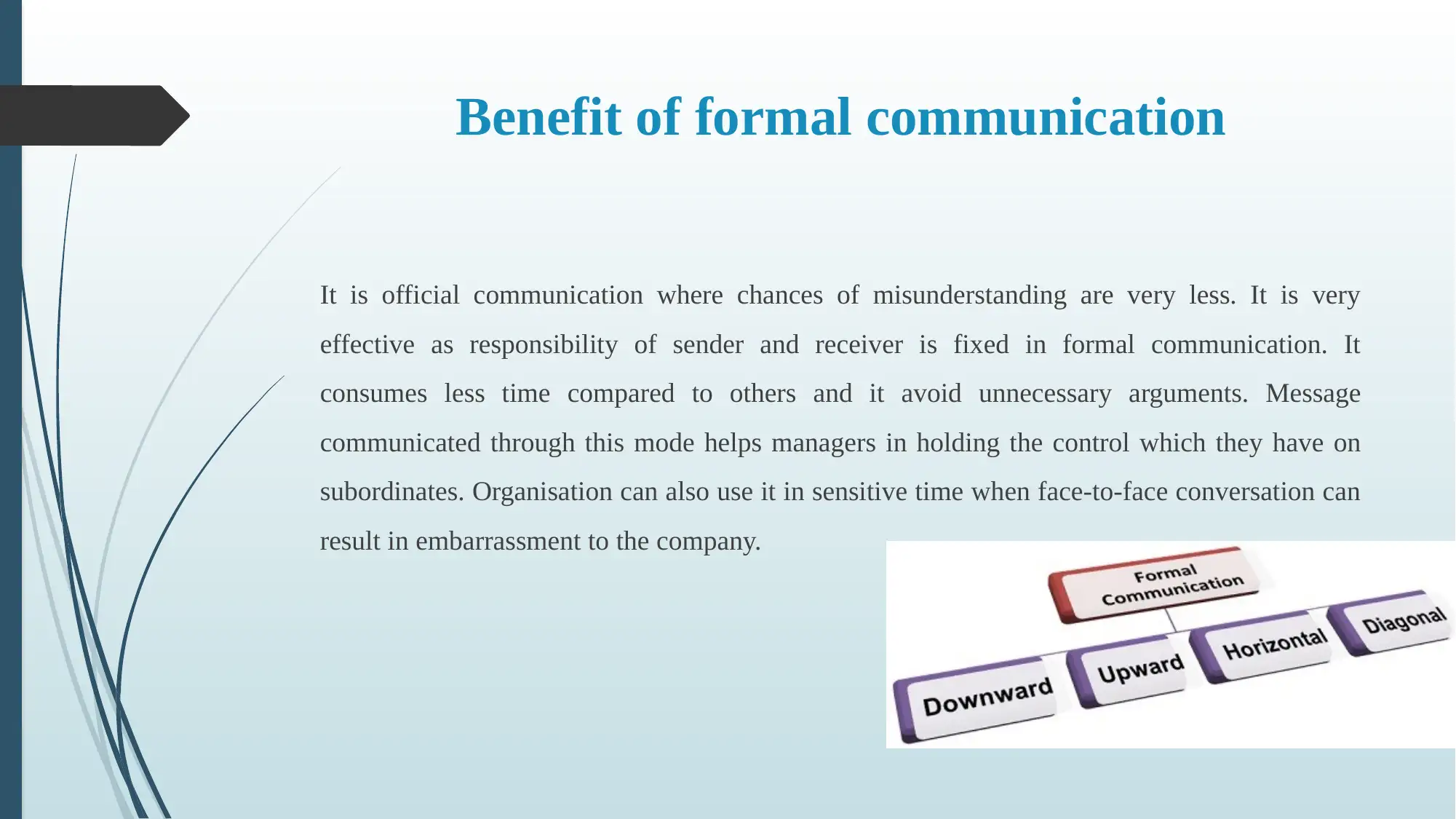
Benefit of formal communication
It is official communication where chances of misunderstanding are very less. It is very
effective as responsibility of sender and receiver is fixed in formal communication. It
consumes less time compared to others and it avoid unnecessary arguments. Message
communicated through this mode helps managers in holding the control which they have on
subordinates. Organisation can also use it in sensitive time when face-to-face conversation can
result in embarrassment to the company.
It is official communication where chances of misunderstanding are very less. It is very
effective as responsibility of sender and receiver is fixed in formal communication. It
consumes less time compared to others and it avoid unnecessary arguments. Message
communicated through this mode helps managers in holding the control which they have on
subordinates. Organisation can also use it in sensitive time when face-to-face conversation can
result in embarrassment to the company.
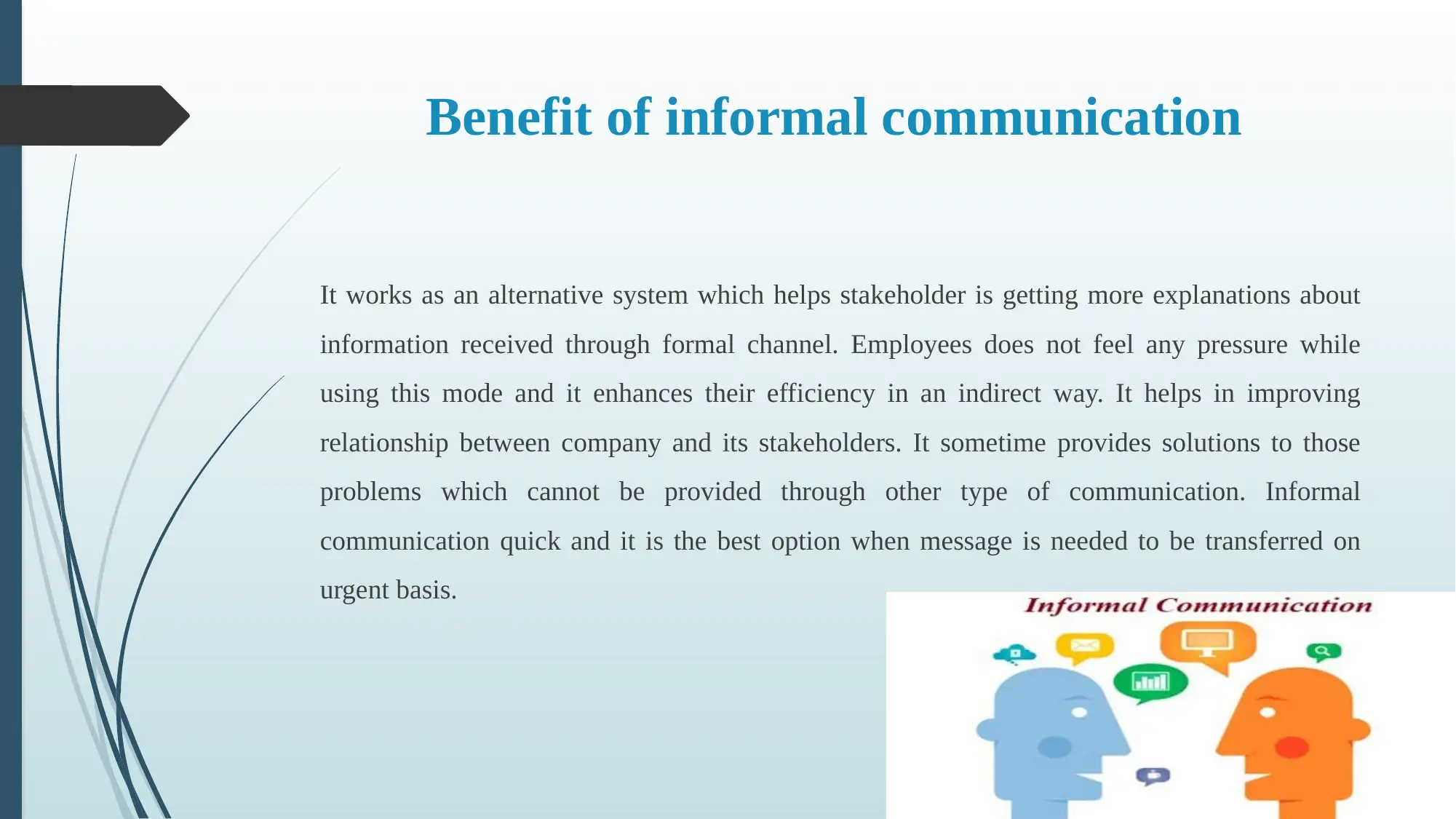
Benefit of informal communication
It works as an alternative system which helps stakeholder is getting more explanations about
information received through formal channel. Employees does not feel any pressure while
using this mode and it enhances their efficiency in an indirect way. It helps in improving
relationship between company and its stakeholders. It sometime provides solutions to those
problems which cannot be provided through other type of communication. Informal
communication quick and it is the best option when message is needed to be transferred on
urgent basis.
It works as an alternative system which helps stakeholder is getting more explanations about
information received through formal channel. Employees does not feel any pressure while
using this mode and it enhances their efficiency in an indirect way. It helps in improving
relationship between company and its stakeholders. It sometime provides solutions to those
problems which cannot be provided through other type of communication. Informal
communication quick and it is the best option when message is needed to be transferred on
urgent basis.
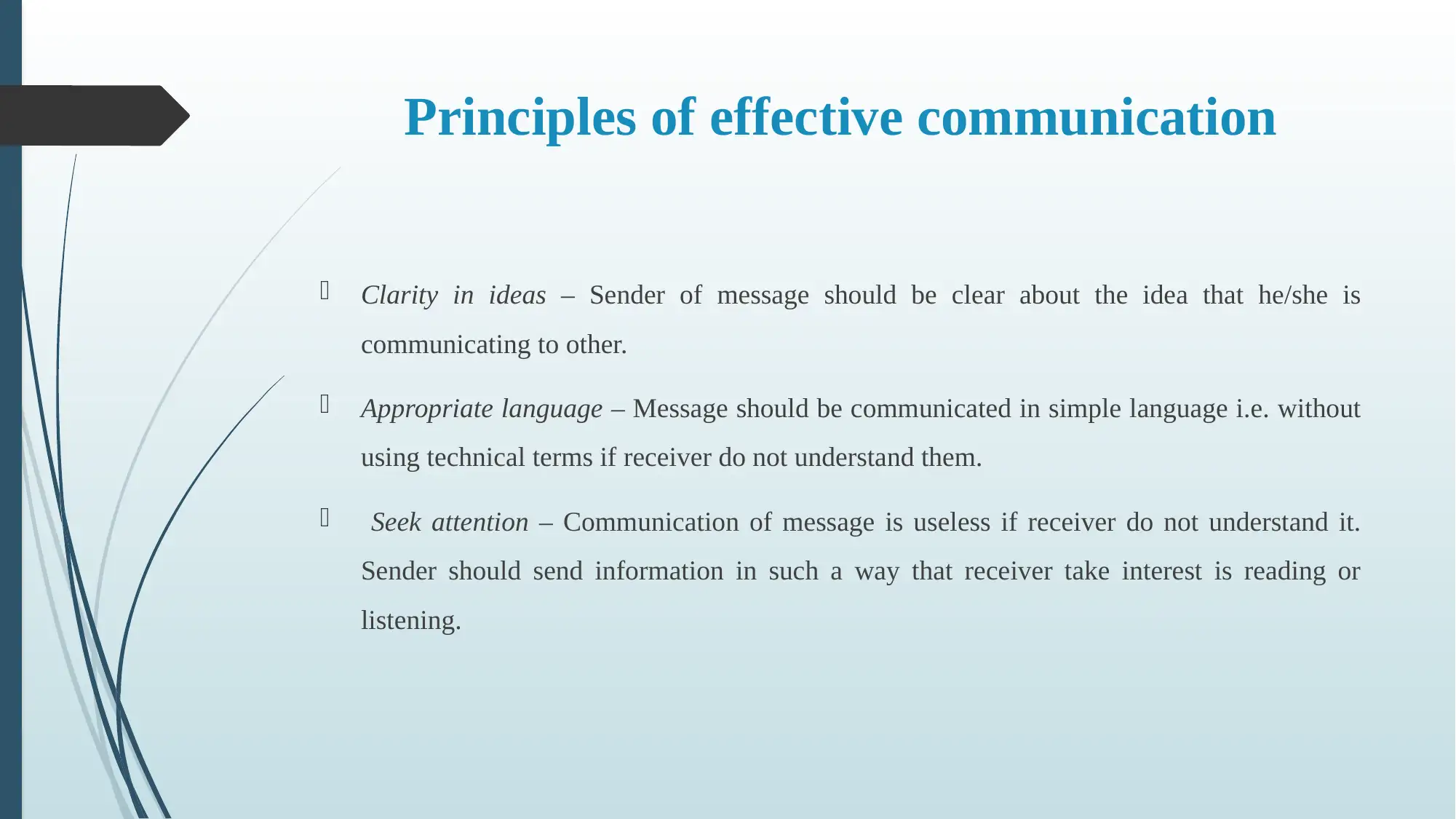
Principles of effective communication
Clarity in ideas – Sender of message should be clear about the idea that he/she is
communicating to other.
Appropriate language – Message should be communicated in simple language i.e. without
using technical terms if receiver do not understand them.
Seek attention – Communication of message is useless if receiver do not understand it.
Sender should send information in such a way that receiver take interest is reading or
listening.
Clarity in ideas – Sender of message should be clear about the idea that he/she is
communicating to other.
Appropriate language – Message should be communicated in simple language i.e. without
using technical terms if receiver do not understand them.
Seek attention – Communication of message is useless if receiver do not understand it.
Sender should send information in such a way that receiver take interest is reading or
listening.
Secure Best Marks with AI Grader
Need help grading? Try our AI Grader for instant feedback on your assignments.
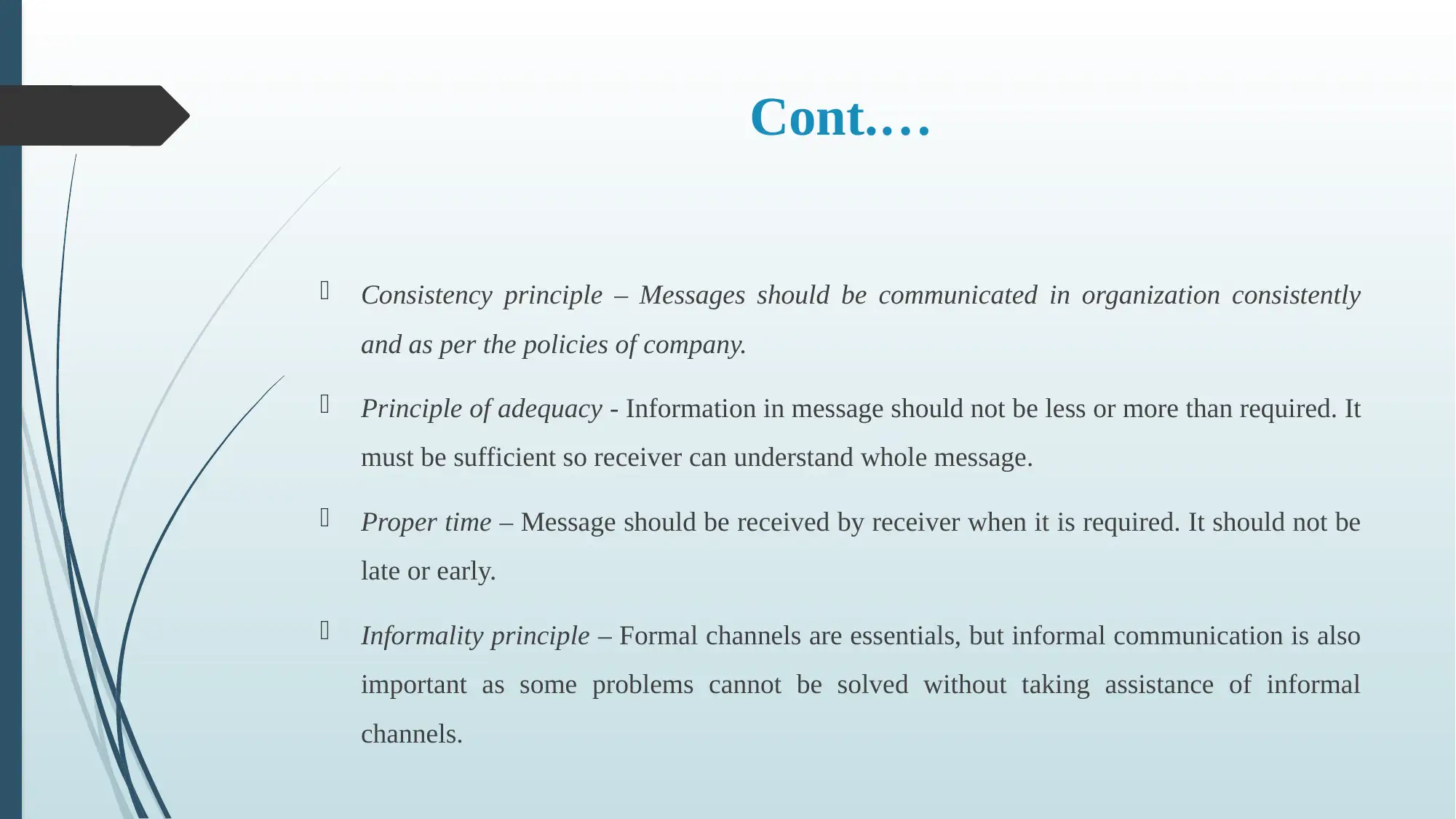
Cont.…
Consistency principle – Messages should be communicated in organization consistently
and as per the policies of company.
Principle of adequacy - Information in message should not be less or more than required. It
must be sufficient so receiver can understand whole message.
Proper time – Message should be received by receiver when it is required. It should not be
late or early.
Informality principle – Formal channels are essentials, but informal communication is also
important as some problems cannot be solved without taking assistance of informal
channels.
Consistency principle – Messages should be communicated in organization consistently
and as per the policies of company.
Principle of adequacy - Information in message should not be less or more than required. It
must be sufficient so receiver can understand whole message.
Proper time – Message should be received by receiver when it is required. It should not be
late or early.
Informality principle – Formal channels are essentials, but informal communication is also
important as some problems cannot be solved without taking assistance of informal
channels.
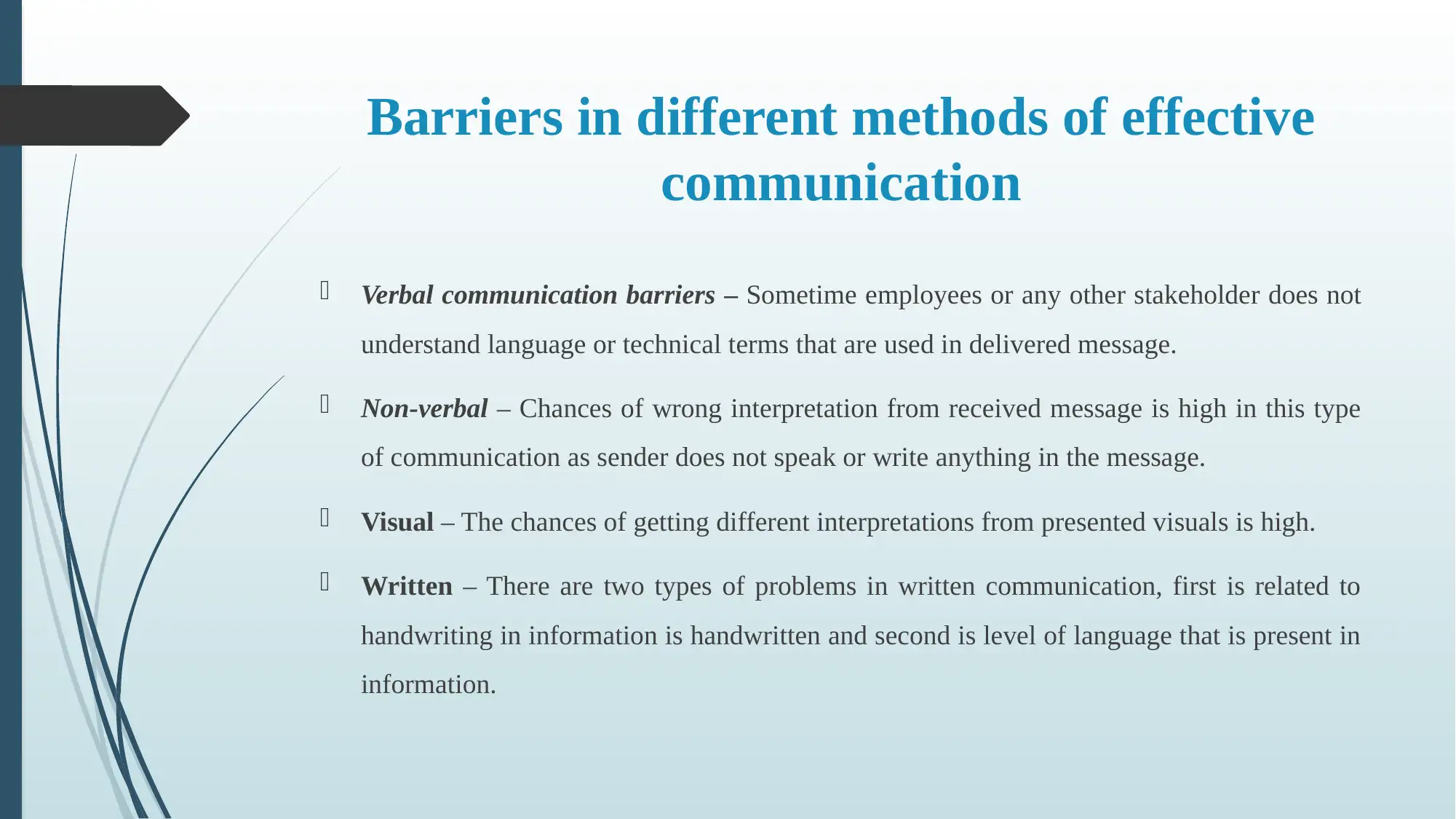
Barriers in different methods of effective
communication
Verbal communication barriers – Sometime employees or any other stakeholder does not
understand language or technical terms that are used in delivered message.
Non-verbal – Chances of wrong interpretation from received message is high in this type
of communication as sender does not speak or write anything in the message.
Visual – The chances of getting different interpretations from presented visuals is high.
Written – There are two types of problems in written communication, first is related to
handwriting in information is handwritten and second is level of language that is present in
information.
communication
Verbal communication barriers – Sometime employees or any other stakeholder does not
understand language or technical terms that are used in delivered message.
Non-verbal – Chances of wrong interpretation from received message is high in this type
of communication as sender does not speak or write anything in the message.
Visual – The chances of getting different interpretations from presented visuals is high.
Written – There are two types of problems in written communication, first is related to
handwriting in information is handwritten and second is level of language that is present in
information.
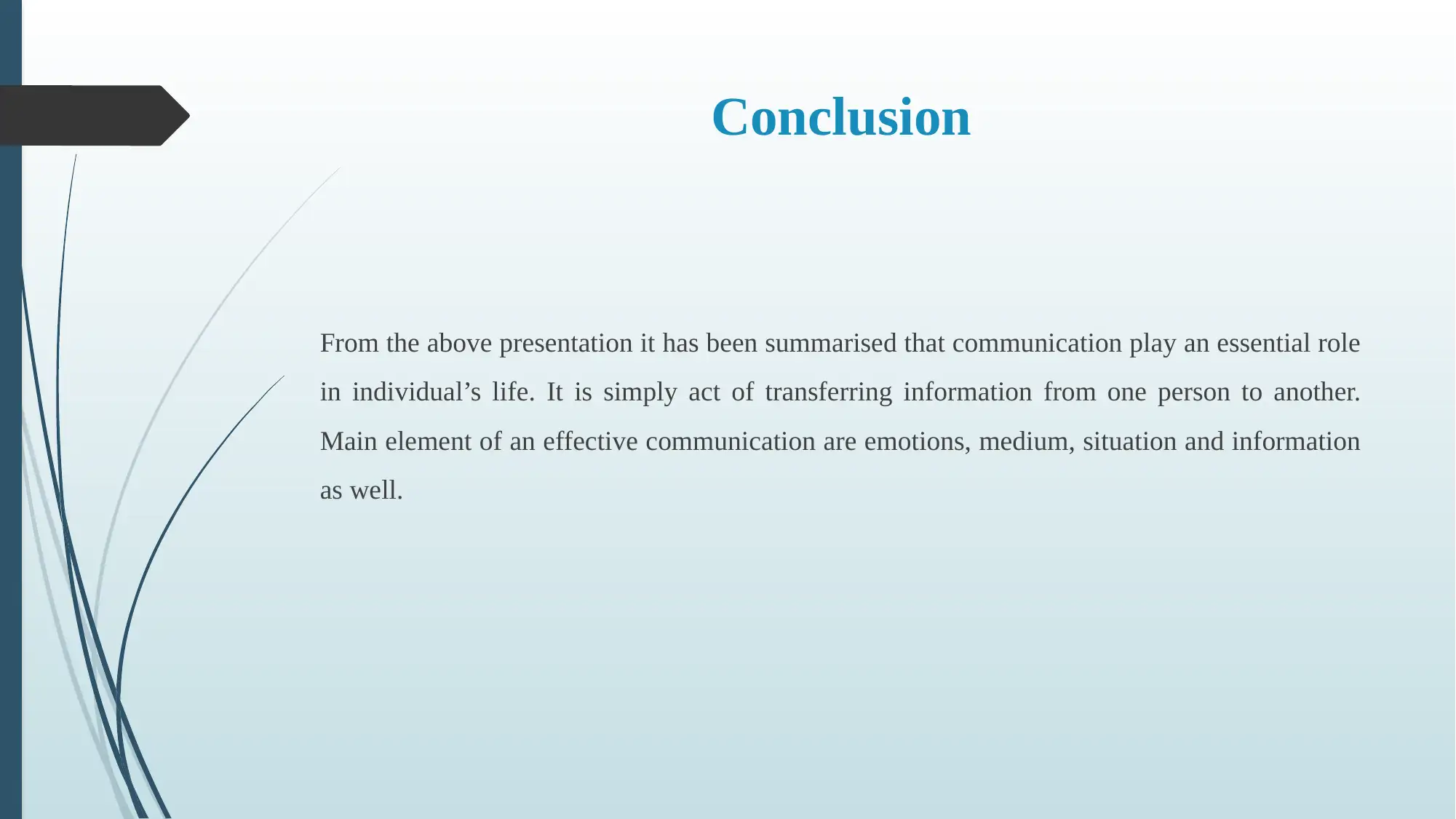
Conclusion
From the above presentation it has been summarised that communication play an essential role
in individual’s life. It is simply act of transferring information from one person to another.
Main element of an effective communication are emotions, medium, situation and information
as well.
From the above presentation it has been summarised that communication play an essential role
in individual’s life. It is simply act of transferring information from one person to another.
Main element of an effective communication are emotions, medium, situation and information
as well.
Paraphrase This Document
Need a fresh take? Get an instant paraphrase of this document with our AI Paraphraser
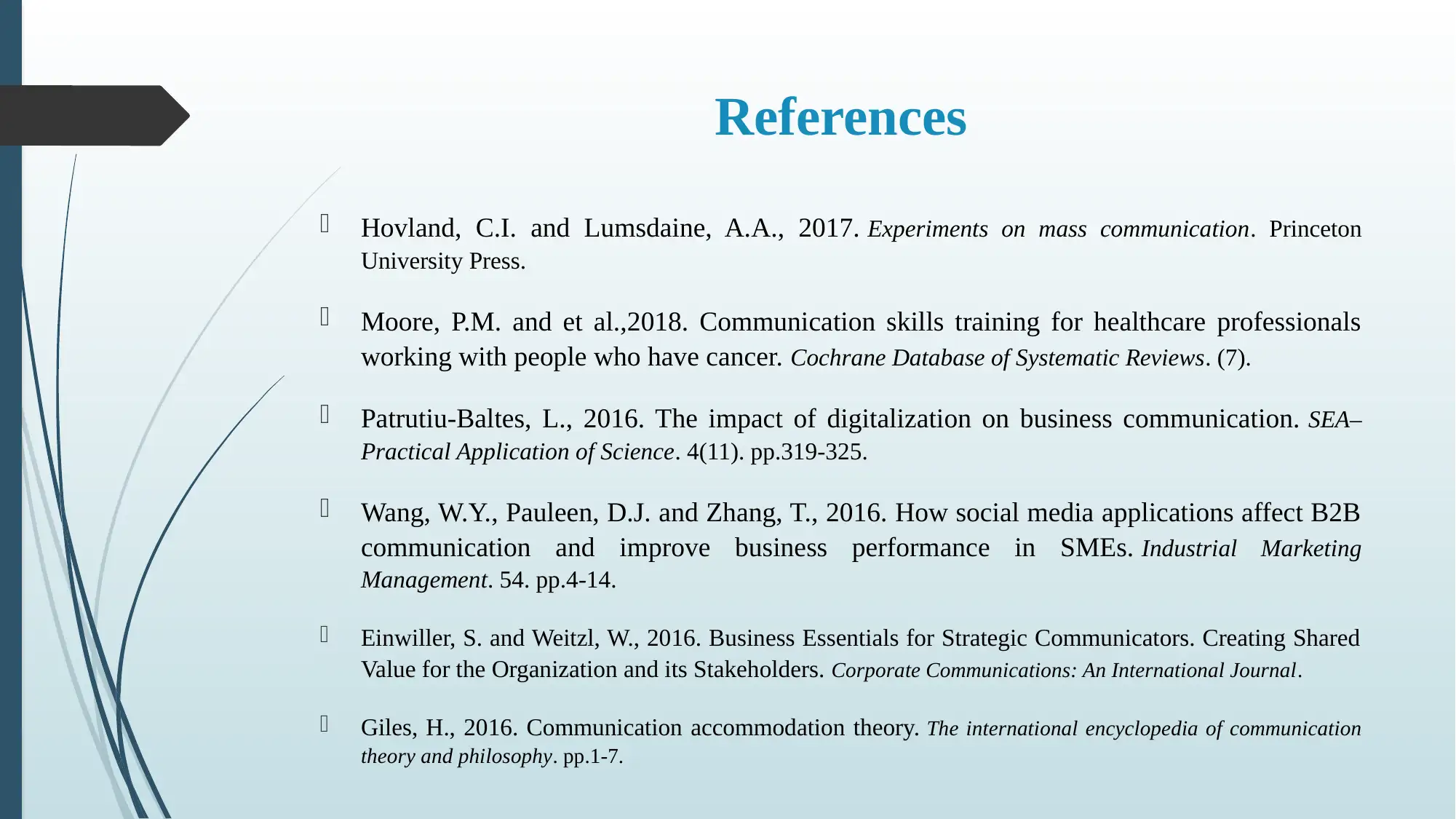
References
Hovland, C.I. and Lumsdaine, A.A., 2017. Experiments on mass communication. Princeton
University Press.
Moore, P.M. and et al.,2018. Communication skills training for healthcare professionals
working with people who have cancer. Cochrane Database of Systematic Reviews. (7).
Patrutiu-Baltes, L., 2016. The impact of digitalization on business communication. SEA–
Practical Application of Science. 4(11). pp.319-325.
Wang, W.Y., Pauleen, D.J. and Zhang, T., 2016. How social media applications affect B2B
communication and improve business performance in SMEs. Industrial Marketing
Management. 54. pp.4-14.
Einwiller, S. and Weitzl, W., 2016. Business Essentials for Strategic Communicators. Creating Shared
Value for the Organization and its Stakeholders. Corporate Communications: An International Journal.
Giles, H., 2016. Communication accommodation theory. The international encyclopedia of communication
theory and philosophy. pp.1-7.
Hovland, C.I. and Lumsdaine, A.A., 2017. Experiments on mass communication. Princeton
University Press.
Moore, P.M. and et al.,2018. Communication skills training for healthcare professionals
working with people who have cancer. Cochrane Database of Systematic Reviews. (7).
Patrutiu-Baltes, L., 2016. The impact of digitalization on business communication. SEA–
Practical Application of Science. 4(11). pp.319-325.
Wang, W.Y., Pauleen, D.J. and Zhang, T., 2016. How social media applications affect B2B
communication and improve business performance in SMEs. Industrial Marketing
Management. 54. pp.4-14.
Einwiller, S. and Weitzl, W., 2016. Business Essentials for Strategic Communicators. Creating Shared
Value for the Organization and its Stakeholders. Corporate Communications: An International Journal.
Giles, H., 2016. Communication accommodation theory. The international encyclopedia of communication
theory and philosophy. pp.1-7.

Thank You
1 out of 15
Related Documents
Your All-in-One AI-Powered Toolkit for Academic Success.
+13062052269
info@desklib.com
Available 24*7 on WhatsApp / Email
![[object Object]](/_next/static/media/star-bottom.7253800d.svg)
Unlock your academic potential
© 2024 | Zucol Services PVT LTD | All rights reserved.





